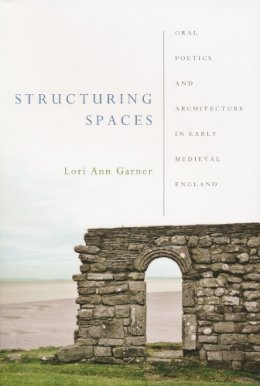10%OFF
Stock image for illustration purposes only - book cover, edition or condition may vary.
Structuring Spaces: Oral Poetics and Architecture in Early Medieval England (ND Poetics of Orality and Literacy)
Lori Ann Garner
FREE Delivery in Ireland
Description for Structuring Spaces: Oral Poetics and Architecture in Early Medieval England (ND Poetics of Orality and Literacy)
Paperback. Num Pages: 456 pages, Illustrations. BIC Classification: AM; DSBB. Category: (G) General (US: Trade). Dimension: 230 x 152 x 21. Weight in Grams: 586.
In Structuring Spaces: Oral Poetics and Architecture in Early Medieval England, Lori Ann Garner illuminates the idiomatic and traditional meanings invested in depictions of architecture within the vernacular verse of early medieval England, portrayals that consistently demonstrate a shared aesthetic between literary texts and physical buildings. Through systematic exploration of the period's verbal and material culture as complementary art forms, Garner argues that in Anglo-Saxon England the arts of poetry and building emerged from the same cultural matrix. Not only did Anglo-Saxon builders and poets draw demonstrably from many of the same traditionally encoded motifs and images, but so rhetorically ... Read morepowerful was the period's architectural poetics that its expressive force continued in literature and architecture produced long after the Norman Conquest.
Far from conceiving this inherited tradition as monolithic in nature, Structuring Spaces foregrounds the complex interface of orality and literacy as a nexus of varied and multivalent cultural traditions that influenced the production of texts and buildings alike. After establishing a model of architectural poetics based on oral theory and vernacular architecture, Garner explores fictionalized buildings in such works as Beowulf and the Ruin, architectural representation in Old English adaptations of Greek and Latin works, uses of architectural metaphor, and themes of buildings in Anglo-Saxon maxims, riddles, elegies, hagiographies, and charms. Her book draws on scholarship from art history, archaeology, anthropology, and architecture, as well as the great wealth of studies addressing the literature itself.
Show Less
Product Details
Publisher
University of Notre Dame Press
Place of Publication
Notre Dame IN, United States
Shipping Time
Usually ships in 7 to 11 working days
About Lori Ann Garner
Lori Ann Garner is assistant professor of English at Rhodes College, Memphis, Tennessee.
Reviews for Structuring Spaces: Oral Poetics and Architecture in Early Medieval England (ND Poetics of Orality and Literacy)
"In this wide-ranging and lavishly-illustrated study, Lori Garner effectively aligns the established approach of oral poetics with insights from the emerging field of vernacular architecture. From Heorot to Grendel's mere, from the Mermedonian prison of Andreas to the nest of The Phoenix, from the Wife's earth-hall to Holofernes' tent, Garner's sensitive readings of the poetics of built spaces in Old ... Read moreEnglish poetry open up new perspectives on 'conventional' imagery that we only thought we knew how to read." —Charles D. Wright, University of Illinois "In this interdisciplinary study, complete with 32 illustrations, Garner explores how poetic and architectural traditions of early medieval England draw on traditional encoded motifs and images relating to spaces. . . . The eloquent afterword reframes the argument in terms of modern interactions with medieval architecture and calls for increased awareness of medieval spaces and the poetry they embody." —Choice “Garner’s Structuring Spaces is a very well-researched monograph, nicely structured, filled with nuanced, considered analysis and fine writing. The strength of the book is in the way it illuminates words and phrases (and through words and phrases, images) across the poetic corpus. The book is well-worth consulting for its illuminating explication of words, phrases, formulas, and images related to building and architecture; for its overall argument about the importance of space in an understanding of Anglo-Saxon culture; and as a fine example of interdisciplinary scholarship.” —Review of English Studies “Lori Garner comprehensively demonstrates that the architecture and the poetry of the Anglo-Saxons drew from a single body of traditional encoded symbols and images. Furthermore, the architectural poetics developed in early medieval England endured under Norman rule.” —Parergon “Lori Ann Garner’s engaging monograph focuses on the architectural phraseology and imagery found in early medieval poetry and its reception by medieval and modern audiences and readers. Harnessing John Miles Foley’s established theory of ‘traditional referentiality,’ she effectively redesigns the way we think, read, and appreciate architectural imagery in Anglo-Saxon and early Middle English poetry.” —Modern Language Review “Expanding our window into the past, Lori Garner reads meaning embedded in larger contexts, marking for attention parallels between Anglo-Saxon architecture and poetics. . . . She unites Carel Bertram’s constructed architecture as shared memory with poetics as ‘carrier of the memory of a once-intact world of spiritual values.’” —Journal of Folklore Research “Garner’s study is an excellent example of interdisciplinary work: rather than simply gesturing towards an integration of disciplines, Garner’s study of Old English oral poetics and Anglo-Saxon architecture is one of the best, most thorough integrations of Anglo-Saxon literary study and material culture I have read.” —Review of English Studies “A detailed pursuit of a highly charged theme, Structuring Spaces centers around the reception and perceptions of the Anglo-Saxon audience toward the architectural phraseology and imagery imbued within oral poetics through a network of signification (phrases, scenes, and poetic patterns) informed by traditional context. Garner challenges readers to explore how the dynamic nature of Anglo-Saxon cultural identity was informed by a synthesis of social, political, and cultural factors inherent within both built and imaginary spaces to conclude that poets, scribes, artists, and buildings all shared a common culturally specific architectural language used to transmit similar meanings.” —Sixteenth Century Journal “This is an attractive book, articulate, jargon-free, well researched, argued with generous cross-references among medieval texts, and well edited.” —Journal of English and Germanic Philology “The strength of Garner’s study is the way in which she draws together material from across the corpus of Old English verse and brings it into dialogue with material culture. . . . Garner’s ideas will undoubtedly serve as a stimulus to further work.” —Medium Ævum Show Less

